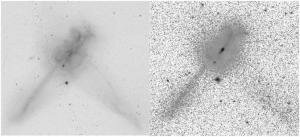Galaxy Merger Dilemma Solved
Scientists at the Naval Research Laboratory have solved a long-standing dilemma about the mass of infrared bright merging galaxies.
Because galaxies are the largest directly observable objects in the universe, learning more about their formation is key to understanding how the universe works.
Dr. Barry Rothberg and Dr. Jacqueline Fischer, both of the Infrared-Submillimeter Astrophysics & Techniques Section in the Remote Sensing Division, used new data from the 8-meter Gemini-South telescope in Chile along with earlier results from the W. M. Keck-2 10-meter and University of Hawaii 2.2-meter telescopes in Hawaii and archival data from the Hubble Space Telescope, to solve the problem. They have published a paper on their research findings on galaxy evolution in the Astrophysical Journal.
Galaxies in the Universe generally come in two shapes, spiral, like our own Milky Way, and elliptical, in which the stars move in random orbits, Rothberg explains.
The largest galaxies in the Universe are elliptical in shape and how they formed is central to our understanding how the Universe has evolved over the last 15 billion years. The long-standing theory has been that spiral galaxies merge with each other forming most of the elliptical galaxies in the Universe. Spiral galaxies contain significant amounts of cold hydrogen gas.
When they merge, the beautiful spiral patterns are destroyed and the gas is converted into new stars. The more gas present in the spiral galaxies, the more stars are formed and with it, large amounts of dust. The dust is heated by the young stars and radiates energy at infrared wavelengths.

"Optical (left) and Infrared (right) image of an IR-bright merging galaxy. The center of the merger is obscured in the left image, but in the infrared (right) the central disk is very bright and easily seen. (Credit: Optical image from the Hubble Space Telescope and infrared image from the University of Hawaii 88" telescope)"
Source: Naval Research Laboratory
|